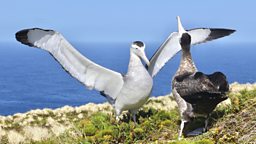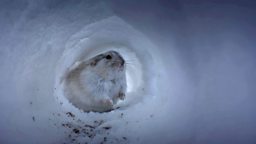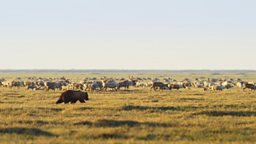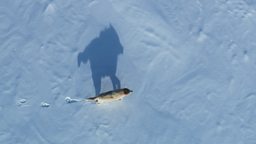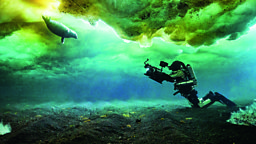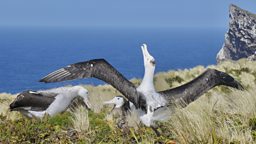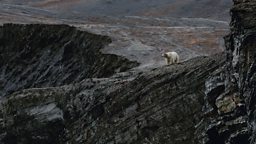Revealing the plight of the Antipodean wandering albatross
By Rachel Wicks, assistant producer for Frozen Planet II
they face arguably their greatest challenge - finding a lifetime partner for breeding
Few people beyond shipwrecked sailors and a handful of intrepid scientists have set foot on the remote subantarctic island of Antipodes, 500km southeast of New Zealand. But after a necessarily strict gear quarantine – important to protect the island's unique and untouched ecosystem – a small Frozen Planet II film crew set sail from Bluff, on a 3-day voyage across the rolling Southern Ocean, towards Antipodes Island.
Here, the incredible Antipodean wandering albatross which have been foraging over the South Pacific Ocean all winter, return to their home island - where they face arguably their greatest challenge - finding a lifetime partner for breeding.
Arriving on the speck of land otherwise uninhabited we got acquainted with our new neighbours. The weather was relatively kind to us but living alongside a ‘castaway’ hut was a reminder of how hostile it could be. Gales regularly buffet the exposed island, but the enormous seabirds, with their massive three-metre wingspan, make using the wind look effortless as they glide by.
Less equipped for their short spells on land, however, these large birds look almost as uneasy walking about as we did, navigating our way through the deep and uneven tussocks and scrub, laden with heavy camera gear and careful to avoid a vast network of burrowing petrel’s nests.

Watching as female albatross flew in, we would see them circle many times, considering males below 'sky calling' up to them – and a multitude of single males soon stood out across the landscape. Where subsequent courtship would historically have been one on one, as females landed, we began to see multiple males rushing in to compete for the female’s attention in a frenzied dance-off. The Antipodes has essentially become an island of widowers with males now outnumbering females 3 to 1. So in Frozen Planet II, we focused our story on a young male trying to attract a female partner. When he’s unsuccessful as a result of declining females numbers, our male seeks companionship with another male.
an island of widowers with males now outnumbering females 3 to 1
This situation came to light due to dedicated scientists Kath Walker and Graeme Elliott who work for the New Zealand Department of Conservation. For over three decades they have left summer in New Zealand each year, sailing with inevitable seasickness to reach the cold, wet and windy Subantarctic island to study the albatrosses. Over 2-3 months they count the birds to check who’s there, map their nesting sites and don them with numbered bands so they can keep personal accounts.
In recent years they’ve also been able to put satellite trackers on some of the birds, to learn more about exactly where they’re going when they leave the island, and why so many females are not returning.
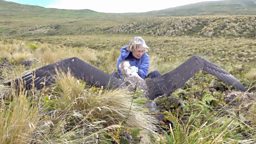

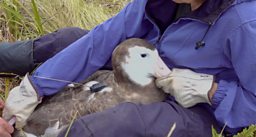
The data that these tags provide is invaluable, especially insights gained from females. They have smaller wings than males so can forage in the lighter winds north of the “Roaring Forties”. Changing oceanic conditions have seen females expand their range even further north than before. There they are increasingly overlapping with tuna fishing fleets, all setting long lines with thousands of hooks baited with squid and fish – the bird’s natural prey. Birds that swallow baited hooks get dragged underwater as the line sinks and they drown.
we could see a complete reversal in the fate of these wonderful seabirds
We’re losing around 12% of females annually. They’re just not making it back.
These birds typically mate for life, forming partnerships for up to 50 years – but now, Kath and Graeme can only look on as year after year they see the same male albatrosses arrive at the colony to wait by their nest for a partner who sadly won’t return. A heart-wrenching scene.
Increasing records of male-male pairs perhaps provide some comfort to the otherwise solitary birds, but this won’t save the species. It’s estimated we are losing 2,300 birds a year from Antipodes Island – the only population of this subspecies. At current rates, within just 30 years they could reach a point of no return.
However, this needn’t be such a sad story – there is hope for these magnificent birds - whilst the reasons behind their changing foraging ranges may be complex and not yet fully understood, thanks to Kath and Graeme’s rigorous studies, the cause of their demise is known and there are relatively simple, cheap and proven solutions which could minimise this bycatch. Kath and Graeme believe that if retailers and consumers demand albatross-safe tuna and the like, fisheries would have to implement these measures - and we could see a complete reversal in the fate of these wonderful seabirds.
